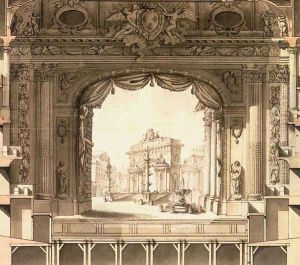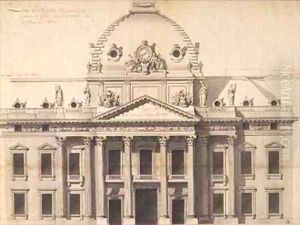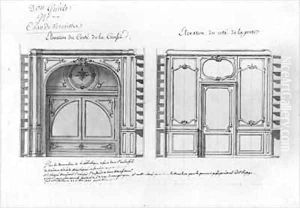Ange-Jacques Gabriel Paintings
Ange-Jacques Gabriel was an influential French architect who became one of the most prominent figures in the field during the 18th century. Born on October 23, 1698, in Paris, Gabriel came from a family with a strong architectural lineage; his father, Jacques V Gabriel, was also a well-known architect. Educated by his father and later at the prestigious French Academy in Rome, Gabriel was deeply influenced by classical architecture and the emerging Rococo style.
Gabriel became the principal architect to King Louis XV, and his career is notably associated with the refinement and consolidation of the French classical tradition. He was appointed the director of the Academy of Architecture in 1734 and became the First Architect to the King in 1742. In these roles, he had significant influence over the architectural practice in France, presiding over the design and construction of royal buildings and other significant structures.
His works include the completion of the Place de la Concorde, the École Militaire, and the Petit Trianon at Versailles. Gabriel's masterpiece is often considered to be the Place de la Concorde (originally Place Louis XV), which epitomizes his skill in creating grand urbanistic designs in harmony with the classical architectural language. His designs were characterized by their elegance, clarity, and harmonious proportions, often incorporating classical elements such as columns, pediments, and balustrades with a restrained and refined approach.
Gabriel also made significant contributions to the Palace of Versailles, the epitome of French grandeur and absolutist architecture. He designed the Petit Trianon, a small château on the grounds of Versailles that became associated with Queen Marie Antoinette, who favored the intimate and less formal space over the grand palace. The Petit Trianon is considered an excellent example of neoclassical architecture, with its clean lines and return to classical simplicity.
Ange-Jacques Gabriel's influence extended beyond individual projects to include urban planning and the standardization of architectural practice in France. His tenure as the First Architect to the King helped to solidify the French neoclassical movement, which would come to full fruition in the following century. His death on January 4, 1782, marked the end of an era in French architecture, and his legacy influenced many subsequent architects in France and beyond.


